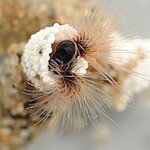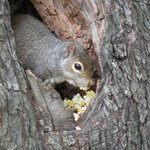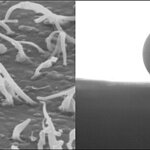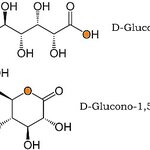Chemistry
A team of chemical engineers have discovered what may be the "ancestral Eve" crystal that billions of years ago gave life on Earth its curious and exclusive preference for so-called left-handed amino acids. The results are published in Crystal Growth and Design.
Researchers used mixtures of both left- and right-handed aspartic acid (an amino acid) in laboratory experiments to see how temperature and other conditions affected formation of crystals of the material.
They found that under conditions that could have existed on primitive Earth, left-handed aspartic acid crystals could have…

By Ladd (DePaul University student)
Have you ever broke a bone before and did it take multiple months for it to heal? Did you wish that there was a way that you could just "glue" it back together so it could heal faster? Well, this might be very possible in the near future! Recently, scientists at the University of Utah in Salt Lake City discovered a way to use a natural substance that could revolutionize the world of medicine concerning fractured bones.
It involves using a product that is based off of the secretions of a marine worm to "glue" fractured bones together. These sandcastle worms…

Ethanol is used to make alcohol, distillation of the mixture leads to the isolation of pure ethanol, a good alternative to petrol. there is a debate among ecologists and scientists whether to use corn or cellulose to manufacture ethanol.
There are a group of scientists that believe cellulose is a better feedstock for ethanol than corn. it has been argued that the expansion of corn ethanol is damaging wildlife and the environment. As more cornfields are grown, protected land is being lost, and the birds are unable to use the corn as a habitat.
Corn requires large amounts of fertiliser, this…

What started my scientific wondering about popcorn? I was reading press-releases about presentations at the American Chemical Society's 239th meeting happening this week in San Francisco while craving a healthy snack.
Suddenly, I remembered my favorite report from last year's ACS meeting, about popcorn's antioxidant polyphenols.
According to a 2005 study published on the American Journal of Clinical Nutrition website, polyphenols go beyond their well-known antioxidant effects in helping prevent cardiovascular diseases and cancers.
Then I began searching for…

Scientists have development of a new carbon dating method to determine the age of mummies, artwork, and other relics without damaging them.
Presenting at the National Meeting of the American Chemical Society (ACS), they say the method, called Non-Destructive Carbon Dating, could allow scientific analysis of hundreds of artifacts that until now were off limits because museums and private collectors did not want the objects damaged.
Conventional carbon dating estimates the age of an artifact based on its content of carbon-14 (C-14), a naturally occurring, radioactive form of carbon…

The key to silk's pound-for-pound toughness, which exceeds that of steel, is its beta-sheet crystals, the nano-sized cross-linking domains that hold the material together, say researchers writing in Nature Materials.
Using computer models, researchers simulated how the components of beta sheet crystals move and interact with each other. They found that an unusual arrangement of hydrogen bonds--the "glue" that stabilizes the beta-sheet crystals--play an important role in defining the strength of silk.
Hydrogen bonds, which are among the weakest types of chemical bonds, gain strength when…

This weekend, over 10,000 chemists will descent upon San Francisco for the American Chemical Society national meeting. For those of us that are presenting at the conference, we’re spending this week making last minute changes to our presentations, wrapping up work projects and cleaning off our desks. Next week, we’ll be absorbed with research talks&posters, short courses, seminars, luncheons, receptions, a huge vendor exhibit and career fair. While many hours will be spent knee-deep in science, we’ll carve out time to meet-up with old college friends, make new…

A team of researchers has discovered how to efficiently turn carbon dioxide into carbon monoxide using visible light. The discovery opens the doors for scientists to explore what organism is out there – or could be created – to chemically break down the greenhouse gas into a useful form. The results are reported in the Journal of the American Chemical Society.
Researchers succeeded in using an enzyme-modified titanium oxide to get carbon dioxide's electrons excited and willing to jump to the enzyme, which then catalyzes the reduction of carbon dioxide to carbon monoxide. A…

Does Spiderman get wet?
The hunt has been on for some time now for what are called superhydrophobic surfaces. These would be ideal for see-though surfaces such as windscreens and coating for solar cells, where any dirty water that splashes on will simply roll off it like the proverbial duck’s back.
In Artificial Hairy Surfaces with a Nearly Perfect Hydrophobic Response, the authors took their inspiration from spiders, particularly the diving spiders that can gather a bubble of air which they carry with them underwater. Whereas others had previously tried uniform nanofibre…

Can one make plastic from glucose?
When I was young, there appeared on the shelf foods such as kippers that were boil-in-the-bag. I then thought, “is the next stage to eat the bag as well?” This started to look feasible when in the 1980s, ICI had developed bacteria that would convert glucose (or starch, which is a polymer of glucose) into polyhydroxybutyrate (PHB). Given conditions where they cannot convert to glucose all the way into carbon dioxide and water, the bacteria will lay it down into granules of this polymer, in a manner rather similar to that in which…